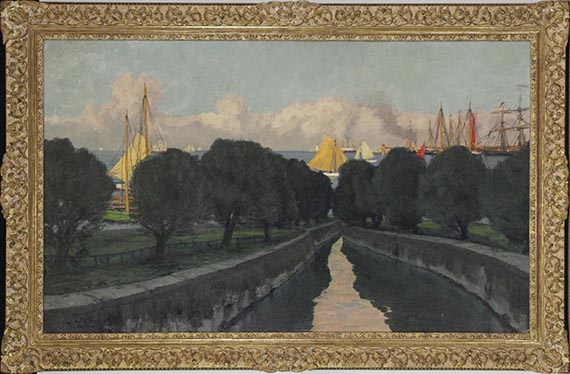344
Walter Leistikow
Hafen, Um 1895.
Oil on canvas
Estimate:
€ 15,000 / $ 17,700 Sold:
€ 27,500 / $ 32,450 (incl. surcharge)
Hafen. Um 1895.
Oil on canvas.
Lower left signed. Verso of the canvas with a stamp of the art supplies store Hermann Neisch & Co, Dresden. Verso of the stretcher with several numbers by hand and in typography, various old numbered and inscribed labels, e.g. of Galerie Heinemann, no. 5070. 73 x 121 cm (28.7 x 47.6 in).
PROVENANCE: Galerie Paul Cassirer, Berlin.
Galerie Heinemann, Munich (verso with the label, no. 5070, on consignment from Paul Cassirer, April 1905).
Galerie Paul Cassirer, Berlin.
Collection Dr. Ulrich Thieme, Leipzig (acquired from the above in 1908).
Private collection Baden-Württemberg.
EXHIBITION: Leipziger Kunstverein, no. 3866 (verso with the label).
Oil on canvas.
Lower left signed. Verso of the canvas with a stamp of the art supplies store Hermann Neisch & Co, Dresden. Verso of the stretcher with several numbers by hand and in typography, various old numbered and inscribed labels, e.g. of Galerie Heinemann, no. 5070. 73 x 121 cm (28.7 x 47.6 in).
PROVENANCE: Galerie Paul Cassirer, Berlin.
Galerie Heinemann, Munich (verso with the label, no. 5070, on consignment from Paul Cassirer, April 1905).
Galerie Paul Cassirer, Berlin.
Collection Dr. Ulrich Thieme, Leipzig (acquired from the above in 1908).
Private collection Baden-Württemberg.
EXHIBITION: Leipziger Kunstverein, no. 3866 (verso with the label).
Walter Leistikow, who played a major role in setting the stage for the advent of modernism in Berlin, is widely recognized as one of the most defining artists of the turn of the century. In 1883, at the age of 17, he left his home town of Bromberg, West Prussia, to attend the Berlin Academy. In his biography of the artist, which was published two years after Leistikow's death, Lovis Corinth, with whom Leistikow formed a close friendship after some initial animosity, wrote that his friend was dismissed from the Academy after six months due to his “lack of talent” (The Life of Walter Leistikow. A Piece of Berlin’s Cultural History, Berlin: Cassirer 1910). No doubt, this was the kind of anti-academic seal of approval that typified the advent of modernist movements around the year 1900. Leistikow finally approached the private studio of Hans Gude, a Norwegian landscape painter of the Düsseldorf School. His first motifs, which he found in the Berlin countryside and his native Pomerania, are entirely rooted in an understated, sincere realism that nevertheless exhibits hints of the delicately tinged color atmosphere of the later Symbolist period. In 1892, Leistikow was among the co-founders of the “Vereinigung der XI” (Association of the XI) group, named simply after the number of its members. Foregoing a mandatory artistic program, the group demanded fundamental changes concerning the selection criteria dictated by jury decisions at exhibitions. A decade later, in 1903, Leistikow and Harry Graf Kessler were involved in the establishment of the Deutscher Künstlerbund (German Artists’ Association) in Weimar. One of Leistikow’s closest friends, the writer and journalist Theodor Wolff, described his landscapes as “realistic Romanticism”. Although based on a realistic impression of nature, Leistikow’s paintings were infused with the artist’s deep empathy which transformed them into psychologically charged landscapes. Through his enthusiastic support of the northern, symbolist-imbued paintings by artists like his friend Edvard Munch, whom he had championed as early as 1893, Leistikow became the representative of the “nervous Romantics” (Hermann Bahr) whose works conveyed a contemplative, mystified visual experience. The eye is drawn along the dark canal towards the sea, providing glimpses of moored boats and sailing ships. Peaceful lines of expansive trees, topped by rosy cloud formations hovering in the distance, shroud the view in enigmatic mystery. [KT]
344
Walter Leistikow
Hafen, Um 1895.
Oil on canvas
Estimate:
€ 15,000 / $ 17,700 Sold:
€ 27,500 / $ 32,450 (incl. surcharge)
Headquarters
Joseph-Wild-Str. 18
81829 Munich
Phone: +49 89 55 244-0
Fax: +49 89 55 244-177
info@kettererkunst.de
Louisa von Saucken / Undine Schleifer
Holstenwall 5
20355 Hamburg
Phone: +49 40 37 49 61-0
Fax: +49 40 37 49 61-66
infohamburg@kettererkunst.de
Dr. Simone Wiechers / Nane Schlage
Fasanenstr. 70
10719 Berlin
Phone: +49 30 88 67 53-63
Fax: +49 30 88 67 56-43
infoberlin@kettererkunst.de
Cordula Lichtenberg
Gertrudenstraße 24-28
50667 Cologne
Phone: +49 221 510 908-15
infokoeln@kettererkunst.de
Hessen
Rhineland-Palatinate
Miriam Heß
Phone: +49 62 21 58 80-038
Fax: +49 62 21 58 80-595
infoheidelberg@kettererkunst.de
We will inform you in time.




 Lot 344
Lot 344 

